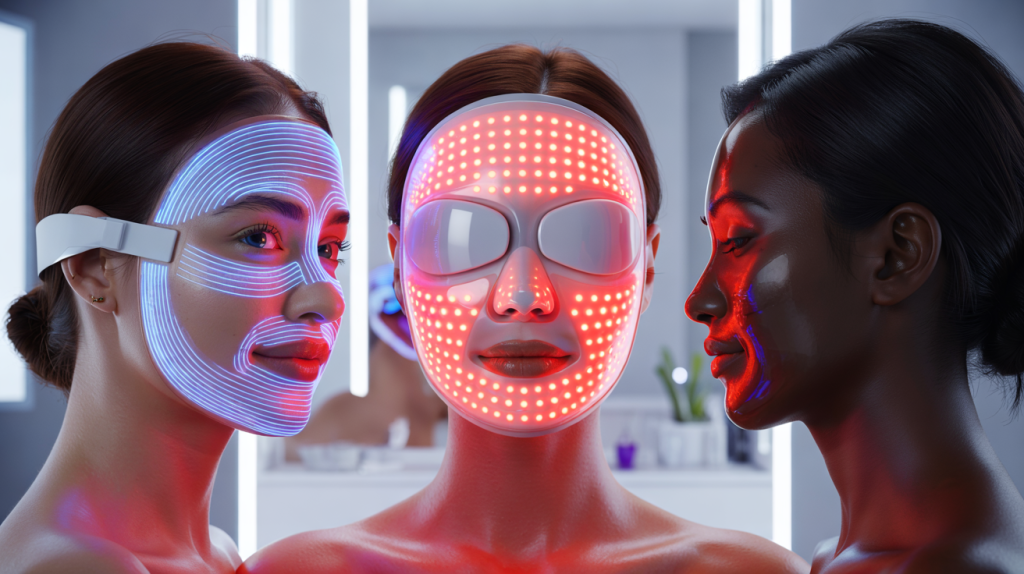LED face masks promise clearer, calmer, firmer skin without clinic visits. The key is not the brand name but the trio that drives results: the wavelengths used, the power actually delivered to skin, and the safety design around eyes and heat. For acne, blue light targets bacteria. For fine lines, red and near infrared help collagen. Pick the right combo and usage rhythm, and the needle moves.
Here is the core truth. Blue around 415 nm reduces Cutibacterium acnes, red near 633 nm calms inflammation and supports fibroblasts, near infrared around 830 nm reaches deeper layers. The American Academy of Dermatology says LED therapy is generally safe and often used two to three times a week for several weeks for visible change. A Cochrane review in 2016 judged the acne evidence modest and low certainty, which is why expectations matter. Safety is not a footnote either. Johnson and Johnson recalled the Neutrogena Light Therapy Acne Mask in July 2019 due to a potential eye risk for some users, a reminder to favour certified eye shielding and clear instructions.
LED mask comparison for skin: wavelengths, goals, and real world fit
First, match light to the problem. Breakouts respond to blue plus red. Texture, mild wrinkles, and tone respond to red plus near infrared. Pigmentation from post acne marks can look better when inflammation drops, though melasma is trickier and needs medical guidance.
Next, coverage and comfort decide consistency. Rigid full face shells cover uniformly, useful for consistent dosing. Flexible silicone wraps fit more face shapes and sit lighter, which helps anyone who tends to stop at week three. Uneven fit means uneven light, especially along the jaw and temples.
Finally, think session time and heat. Most consumer masks run preset sessions of 10 to 20 minutes. Heat should stay minimal. If a device feels hot, that is not more effective light, it is wasted energy and a reason to pause.
Evidence and safety: AAD, Cochrane 2016, and the 2019 recall
The AAD reports that LED treatments can reduce acne and improve signs of photoageing, with minimal downtime and rare side effects when used as directed. Results tend to build gradually across weeks rather than overnight. That rhythm matters more than a single long session.
The 2016 Cochrane review on light therapies for acne found low certainty evidence that blue and red light can lower lesion counts compared with sham treatments. Translation for shoppers. Benefits are real for some, not guaranteed for all, and strongest when devices deliver correct wavelengths consistently to skin.
Regulatory status clarifies scope. In the United States, many at home LED masks are FDA cleared as class II devices for treatment of mild to moderate acne. That clearance does not equal proof for wrinkle reduction or pigmentation unless specifically cleared for those indications. The July 2019 Neutrogena recall showed eye safety matters. Built in eye cups or opaque shields plus instructions to keep eyes closed are not optional.
How to choose a LED face mask at home
Shoppers compare specs, then live with comfort. Here is a fast filter to seperate marketing from utility.
- Wavelength disclosure : look for specific nanometers such as blue 415 nm, red 633 nm, near infrared 830 nm, not vague color names
- Irradiance transparency : manufacturers should state power at the skin in mW per cm², not just total LEDs or watts
- Safety features : eye shielding that blocks direct light, auto shut off timer, materials tested to IEC 62471 for photobiological safety
- Regulatory status : FDA clearance for acne if that is your goal, or equivalent local registration, plus clear contraindications
- Fit and coverage : full face coverage including jawline, adjustable strap, even spacing of diodes to avoid patchy results
- Routine support : preset programs by goal, session reminders, and a mask light enough to wear without slipping
Prices vary widely. Entry devices sit low, premium models climb higher with added wavelengths, stronger output, and better ergonomics. What matters is disclosed specs and a design that users will actually wear four weeks straight.
Routine that works and mistakes that slow results
Clean skin first, then mask, then moisturiser. Sunscreen in the morning stays non negotiable. Makeup can wait until after the light. That order avoids scattering light with residues and keeps the barrier happy.
Common pitfalls are easy to dodge. Skipping sessions breaks the photobiomodulation momentum. Using photosensitising products right before a session can sting. Check labels for ingredients like benzoyl peroxide or retinoids, and space them if irritation shows up. People on photosensitising medications or with eye conditions should consult a clinician before use.
How long to expect change. For acne, some see fewer inflamed bumps after two to four weeks in regular use, in line with the AAD pace of multiple weekly sessions. For texture and fine lines, signs usually appear later because collagen remodelling simply takes longer. A simple notebook or photo log helps track progress you might not notice day to day. Small tip that many recieve and keep.
